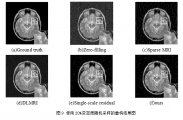基于深度残差扩张网络的磁共振图像重构
来源:56doc.com 资料编号:5D21213 资料等级:★★★★★ %E8%B5%84%E6%96%99%E7%BC%96%E5%8F%B7%EF%BC%9A5D21213
资料以网页介绍的为准,下载后不会有水印.资料仅供学习参考之用. 密 保 惠 帮助
资料介绍
基于深度残差扩张网络的磁共振图像重构(论文12000字)
摘要:目前,磁共振成像(MRI)遇到最大的问题是信号和数据采集比较慢,从而导致成像速度较慢,限制了MRI技术的发展。为了加速MR成像以及获得更好的重构效果,本文提出了一种基于深度残差扩张网络的方法来建立零填充和降采样的k空间数据之间的映射,使用残差学习来获取图像中的全局和局部特征,以恢复图像的细节,使用扩张卷积增大卷积核的感受野,从而减少网络参数以加速成像,提取更多的图像信息。在MR的实数数据上的实验结果显示出所提出方法的有效性和准确性,能够有效减少重构后图像的伪影,加强了对细节方面的处理。实验方面与部分迭代优化算法和深度学习算法进行实验对比,突显此方法在成像速度和重构效果上的优越性。
关键词:磁共振成像,深度学习,深度残差网络,扩张卷积
Magnetic Resonance Imaging Reconstruction Based on Deep ResidualDilated Network
Abstract:Now,MRI is time-consuming with the disadvantages of slower signal and data acquisition speed which limit the development of this technology. In order to accelerate MR imaging and obtain better reconstruction results, we propose a novel method based on deep residual networks to establish non-linearmapping between zero-filled and down-sampled k-space data. Weuse residual learning to capture global and local features to recover image details and structures. Weemploydilated convolutions to increase the receptive field of the convolutional kernel, which can reduce network parameters to speed up imaging and extract multi-scale image information.The experimental results on the real-valued MR images show the effectiveness and accuracy of the proposed method, which can effectively reduce the artifacts of the reconstructed image and strengthen the processing of details. Experimental comparison withseveral iterative optimization algorithm and deep learning algorithm highlights the superiority of this method in imaging speed and reconstruction effect.
Key words: Magnetic Resonance Imaging, deep learning, deep residual networks, dilated convolutions

目录
1 磁共振成像原理及利弊 1
1.1 磁共振成像原理简介 1
1.2 k空间介绍及其与MR图像的关系 1
1.3 磁共振成像的利弊 1
2 磁共振成像重构现状及方法 2
2.1 国内外现状 2
2.2 基于迭代优化算法的CSMRI 2
2.3 基于深度学习的CSMRI 3
2.4 小结 4
3 扩张卷积与残差网络 5
3.1 扩张卷积 5
3.2 残差网络 6
4 网络模型 7
5 实验 8
5.1 数据集介绍 8
5.2 采样方式 9
5.2.1 变密度随机采样(Variable Density Random Sampling) 9
5.2.2 笛卡尔采样(Cartesian Sampling) 10
5.2.3 Radial采样(Radial Sampling) 10
5.3 实施细节 11
5.4 客观性能指标:峰值信噪比(PSNR)和结构相似性(SSIM) 11
5.5 实验结果及分析 12
6 总结与展望 15
6.1 实验总结 15
6.2 展望 15
参考文献 15
致谢 19
|



